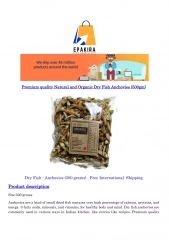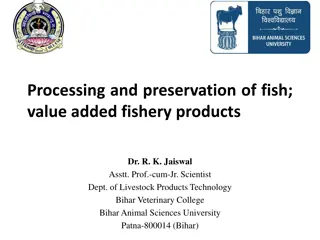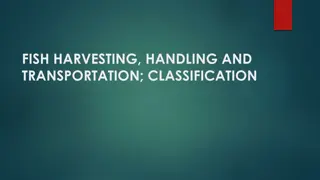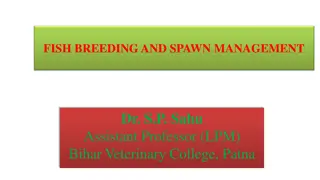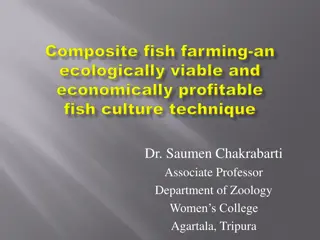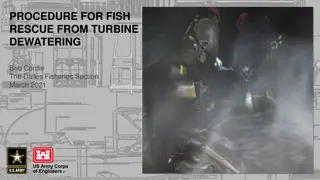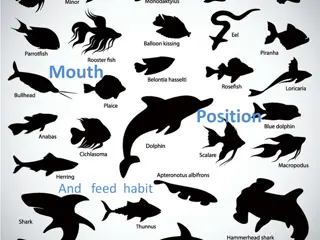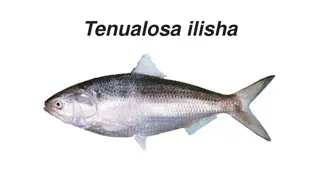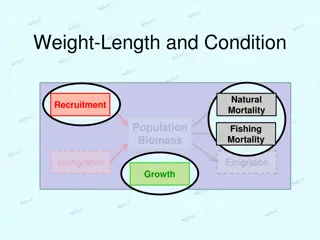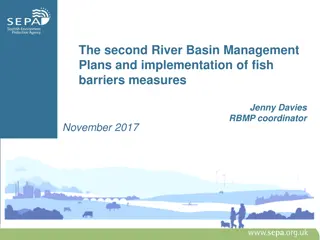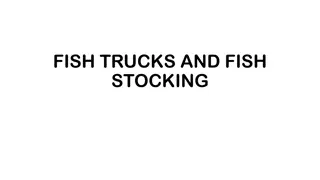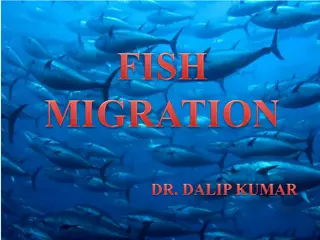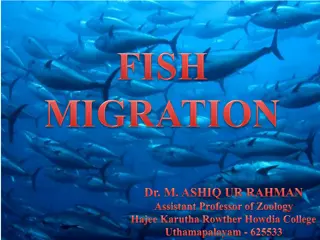Aquatic Epidemiology in Fish Populations
Aquatic epidemiology is a crucial branch of science that focuses on describing the health, diseases, and welfare of fish populations. It involves studying diseases in wild and hatchery-raised fish, identifying factors influencing disease occurrence, and conducting diagnostic investigations to maintain fish health. Fish health experts look for signs of disease in wild populations, hatcheries, and broodstock. Diseases like Flavobacteria, causing bacterial coldwater disease, pose threats to fish health, with symptoms like tissue erosion, jaw ulcers, and fin issues. Effective management strategies involve culling infected fish, water treatment, and disease prevention practices.
Download Presentation

Please find below an Image/Link to download the presentation.
The content on the website is provided AS IS for your information and personal use only. It may not be sold, licensed, or shared on other websites without obtaining consent from the author.If you encounter any issues during the download, it is possible that the publisher has removed the file from their server.
You are allowed to download the files provided on this website for personal or commercial use, subject to the condition that they are used lawfully. All files are the property of their respective owners.
The content on the website is provided AS IS for your information and personal use only. It may not be sold, licensed, or shared on other websites without obtaining consent from the author.
E N D
Presentation Transcript
AQUATIC EPIDEMIOLOGY When we put those two studies together what do we get? Hatcheries rely on fish health experts in the DNR and at MSU to keep fish populations healthy. Diseases might be found in wild populations that the DNR wants to spawn. Or found in hatchery raised young, or adult broodstock fish. Study of disease in fish populations and the factors that determine its occurrence. Links to many other fields Clinical medicine Laboratory medicine Biostatistics Health economics
Aquatic Epidemiology - Branch of laboratory science that seeks to describe the health, diseases, and welfare of fish populations. Asymptomatic - Showing no symptoms of the disease Biostatistics - Branch of statistics that deals with data related to living organisms. Broodstock - Group of mature fish held in hatcheries for breeding purposes. Diagnostic Investigations - Procedure to identify areas of weakness or strength to determine a condition, disease or illness. Health Economics - Field assessing the economic impact of fish health and diseases. Horizontal Gene Transfer - The transmission of disease between organisms. Isolate - a culture of microorganisms isolated for study Multilocus Sequencing - Technique in molecular biology for characterizing isolates of microbial species using DNA sequencing. Pathogen - A bacterium, virus or microorganism that can cause disease. Pathology - Branch of science studying the structural and functional manifestations of disease. Spawning - Release or deposit of eggs. Vertical Transmission - The transmission of disease from parent to offspring. Weir - A low dam temporarily placed across a river to prevent the upstream migration of fish. Weirs direct fish into holding ponds for manual spawning. Wild Stock - Fish growing to adulthood in the wild.
SO WHAT ARE FISH HEALTH EXPERTS LOOKING FOR? If a wild population has disease, biologists might choose not to use them for eggs and milt. If disease is found in a hatchery they may have to treat the whole facility, treat just that species or tank of fish, or they may need to cull those fish. The MSU Department of Pathology and Diagnostic Investigation aids the DNR in conducting health assessments of wild and hatchery fish. Fish testing Adults (broodstock) from the hatchery Adults in the wild Fry in hatcheries
FLAVO BACTERIA Bacterial coldwater disease Caused by bacterium Flavobacterium psychophilum found in freshwater below 15 degrees Celsius. Asymptomatic carrier fish and contaminated water are vectors for the disease to spread.
FLAVO BACTERIA Transmission Horizontal transfer = fish to fish or water to fish Vertical transfer = from adult to egg to fry. (infected eggs) What does infection look like? Tissue erosion Jaw ulcers Inflammation Behavior issues Fins are torn, frayed or missing. Treatment Cull infected fish Treat the water with UV light and antibiotic Treat fish Disinfect eggs
Found in 23 states and 1 province since 1981. 470 known Fp isolates An isolate is a strain of a species, like a breed of dog.
The chart plots the known Flavobacteria isolates. The black dots size indicates occurrence rates (larger is more occurrences). The oval outlines group families of related isolates. The numbers indicate the name of the isolates. While there are many that have been typed, not all are present in Michigan waters/fish. The chart begins to color code those that are found here. Red = 1 state Blue = 2-4 states Green = 5-9 states Yellows = more than 10 states Globes = other countries
KEY TO ABBREVIATIONS Isolate infections in the following activities are described with what is called a lot code . Below is a chart that describes what each portion of the code means. Isolate Strain Year Diagnosed Production or Broodstock Species Code Species Strain Domestic or Wild Source Year Eggs Taken Source of Eggs Hatchery Where fish are raised Hatchery Where Fish are Transferred ST253 2010- P- RBT- MI- W- 10- LMW- TH- WL ST286 2017- B- RBT- EL- D- 12- OD- Source of Eggs Code: LM=Little Manistee Weir PL=Platte River Weir Hatchery Codes: MA = Marquette Hatchery HA = Harrietta Hatchery Species Code Key BNT - Brown Trout CHS - Chinook Salmon COS - Coho Salmon LAT - Lake Trout SE - Seneca LS - Lake Superior RBT - Rainbow Trout EL - Eagle Lake Strain SR - Sturgeon River Strain GC - Gilcrest Creek Strain WR - Wild Rose Strain RBT - MI - Steehead Michigan Winter TH = Thompson Hatchery OD = Oden Hatchery WL = Wolf Lake Hatchery
EXAMPLE 1 ST353-2019-P-LAT-SE-D-17-MA ST278-2012-P-LAT-LS-D-11-MA Only found in Marquette State Fish Hatchery Only found in production fish (not the broodstock in a different building .) Never found in wild fish Only found in Lake Trout. Not even splake in the same facility . Splake is cross of (M)BKT x (F)LAT How can it affect babies, but not the parents? How can it get into the hatchery then? Horizontal Transmission? Vertical Transmission? Occurrence in soil/water?
EXAMPLE 2 ST286-2017-B-RBT-EL-D-12-OD ST286-2019-P-BNT-WR-D-18-HA 2017 broodstock RBT at Oden Hatchery 2018 production BNT raised at Harietta Hatchery (but eggs came from Oden) So affects at least two species . Affected babies and adults . Horizontal Transmission? Vertical Transmission? Occurrence in soil/water?
ACTIVITY 2 A2a A2b ST253-2010-B-BNT-GC-D-04-OD ST253-2013-B-BNT-SR-D-12-OD A2c A2d ST253-2013-P-BNT-WR-12-OD ST253-2013-B-RBT-EL-D-09-OD A2e ST253-2017-B-RBT-EL-D-12-OD

 undefined
undefined





